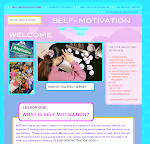 FOR EDUCATORS
FOR EDUCATORSBlogs are a very popular type of Web. 2.0 tool. A blog is a communicative device that allows educators to teach their students by a learn by doing, writing and reflecting method which is a part of the R2D2 Model for multi-media assets. This practice is an improvement from the isolated education cycles of the past where students are given the work and have to regurgitate its comprehension not always through collaborative efforts and peer to peer reflection. Blogs change how information is formulated and then shared amongst peers and scholars alike. Observations in problem-based assessments have governed industries outside of education, namely engineering, medical and scientific. Blogs can be introduced into middle school aged students. While they are building a repertoire of online interaction, they will likely assimulate into further developments that involve education. Teachers can continue to use blogs to promote topics relevant to classwork, enhanced comprehension and teachers feel they promote literacy in the classroom (Hufaker, 2004)* By teachers exercising these simple task involved with blogging, students will develop professionalism in there writings knowing that there comments may hang on the world wide web for another millennium.
TECHNICAL
Blogs have become a conventional and affordable means to communicate information from any computer and all around the world. The enduser needs only basic comprehension of website design and development to implement it. A blogger needs to know very little about authoring tools and web design. Published material becomes immediately accessible to anyone with an internet connection. This added accessibility has been called the democratization of web publishing (Oatman, 2005)*. Can you imagine your ideas being filtered onto a website in Hong Kong? Blogs are world wide as the Web.
FOR THE NEWS AND FREELANCE WRITERS
Blogging has become one of the world's greatest resources. In fact, countless web based news organizations are starting to see the blogs draw to their site. Bloggers are there to be the people reporting events of tomorrow. The social activities connecting us all has defined how we see the world, take in information and react to it. The videos helped me to observe what has been happening right underneath my chin- a whole new possibility of advertising yourself, creating pertinent connections with affluent industries and people connections is what the Internet's about in the 21 century. The video by Commoncraft airing on Youtube, efficiently describes the precision of Blogs and RSS feeds. The movement created with the tiny pieces of pictures on paper was quite an effective tool to show the usage and advances of bloggers. The real face of bloggers are the self determined freelance writers that they are; reporting the news as we see it. Bloggers are the transporting mechanisms of the people's take on a product, viewpoint, experience and related media polls. Theoretically its sufficient to say that the policy of writers gone blogging is in the higher percentiles. Blogging is like how syndicated TV was for Oprah back in the eighties, she had no idea of how much money she could make in syndication.
MOVIES AND BLOGGING
There was a movie most recently about Julia Child's famous French cooking that took a world -wind plunge into a bloggers unique world. Who would of known if you remotely paid attention in english that you would be able to advance into the wonderful of writing in such a way that could create popularity with specific topics that uniquely define the world we live in today. When I spent my funds on that movie rental entitled Julie and Julia, I was surprised to see how low budget the film was; especially with Meryl Streep. I mean there was absolutely nothing to this movie's background- a NY apartment- Julia's so-called French apartment (Canadian shoots). It was simply the wonder-lust of NY city's working class developed into a mixture with french cooking, and writer's block. The Headline reads: a writer decides to add splendor to her half-boring, overworked life with becoming obsessed over Julia Childs, Master French Cooking book with Julia Childs; she makes a vow to blog and to tirelessly cook her 524 recipes within a 365 day year. Woohoo!
Now don't get me wrong, I love Meryl Streep, there isn't a movie that she's done that I haven't seen. Its just that the movie's simplicity makes me want to get my own movie done. Its mostly done in a studio where you can recreate the ambience of Frances outside tea gardens and such. The best parts of this movie were governed by the effects of her blogging; how it shaped her relationships, including almost getting fired at work for bringing her boss into the conversation in one blog. Her boyfriend left her in frustration at her anxiety to complete the task, extended to the more palatable benefits of her blog, which was a couple of book offers from some major book publishing companies and her cooking took it a few notches up.
Equally compelling component was that Julia Child's was madly in love with her first boyfriend/ husband. That was quite interesting when i found out Julia Child's was in her forties when she decided to dedicate her life to cooking and embarked on writing her first book, which took almost three years and 3 different companies to get to the right one- Goldfigure! For an explanation on how this movie got done; they say walk with a giant and you will have the same power as the giant.
References:
West, R., Wright, G., Gabbitas, B., & Graham, C. (2006). Reflections from the Introduction of Blogs and RSS Feeds into a Preservice Instructional Technology Course. TechTrends:
Linking Research & Practice to Improve Learning, 50(4), 54-60. doi:10.1007/s11528-006- 0054-9.
Julie & Julia (2009) Nora Ephron (Screenplay) and Julie Powell (book). Julia Child's story of her start in the cooking profession is intertwined with blogger Julie Powell's 2002 challenge to cook all the recipes in Child's first book.
Commoncraft Website Blogs http://www.commoncraft.com/ viewed on You Tube January 09, 2010.





 At first I became a little frustrated at all the tools that are available online; and not all of them are educationally efficient tools.
At first I became a little frustrated at all the tools that are available online; and not all of them are educationally efficient tools.


